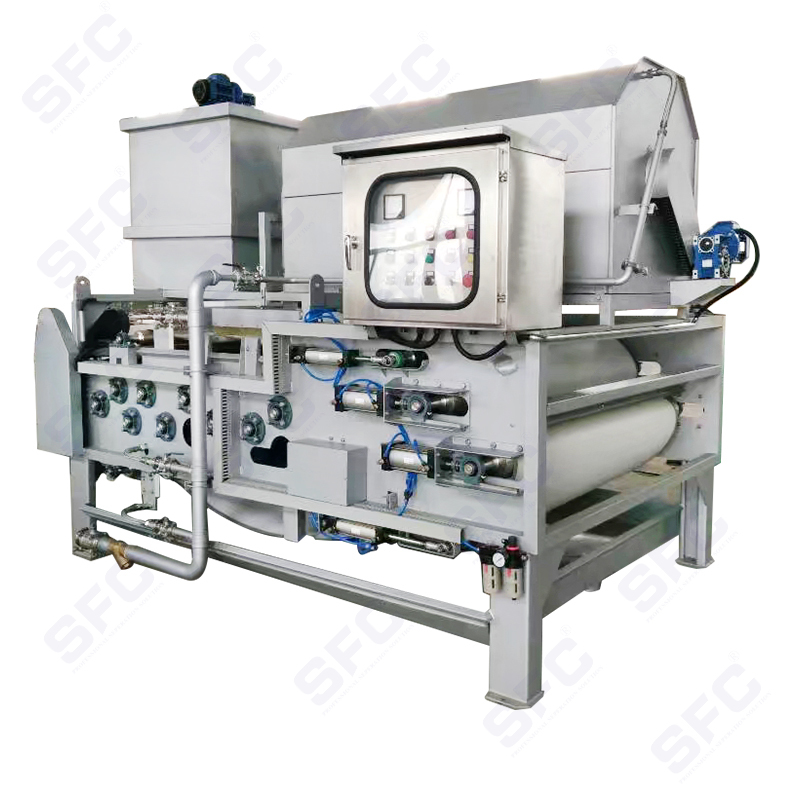How does the sludge dewatering machine improve the sludge treatment efficiency and reduce the environmental protection cost?
Sludge dewatering machine plays a vital role in the modern sewage treatment industry. With the acceleration of industrialization and the advancement of urbanization, sewage treatment has become a key link in environmental protection work, and the treatment and disposal of sludge have received more and more attention. The emergence of sludge dewatering machine solves the problem of large sludge volume and high water content, greatly improving the sludge treatment efficiency and the operability of post-treatment.
In the sewage treatment process, the sludge treated by biological, chemical or physical methods usually has a high moisture content, accounting for about 80% to 95%. If these sludges are not dehydrated, they are large in volume, the cost of storage and transportation is very high, and there is a great risk of environmental pollution. Therefore, effective sludge dewatering can not only reduce the volume and weight of sludge, but also reduce the cost of transportation, storage and disposal, while reducing the impact on the environment.
The basic principle of sludge dewatering machine is to remove moisture from sludge by combining mechanical force and chemical additives. Its common working methods include centrifugal dewatering, plate and frame filter pressing, and belt filter pressing. Each method has different applicable scenarios and advantages and disadvantages, but in general, the working steps of the dewatering machine mainly include the following aspects:
The sludge is passed through the screen to remove large particles of impurities to ensure the quality of the sludge entering the dewatering equipment.
Add an appropriate amount of flocculant to help the fine particles in the sludge condense into larger particles for subsequent dewatering operations.
The water in the sludge is squeezed out by the pressure, centrifugal force or other methods of mechanical equipment to achieve the dehydration effect. The moisture content of the dehydrated sludge is usually reduced to about 70%, at which time it can be further dried, burned or landfilled.
According to the working principle and dehydration effect, sludge dewatering machines can be divided into several common types:
The belt filter press uses the compression of two belt filter cloths in the multi-layer pressing area to squeeze out the water in the sludge. This equipment has the advantages of simple operation and large processing capacity, and is suitable for processing large amounts of low-concentration sludge.
The water in the sludge is thrown out by the centrifugal force of high-speed rotation. The centrifugal dewatering machine has a high processing efficiency and is particularly suitable for the dehydration of fine particle sludge, and can obtain drier dehydrated sludge.

The plate and frame filter press continuously increases the pressure between the filter plates to discharge the water in the sludge from the gap between the filter plates. This equipment is suitable for treating sludge with higher concentrations, especially in the treatment of industrial wastewater with higher solid concentrations.
The rotation of the spiral shaft drives the sludge forward along the axial direction, and the water is gradually squeezed out through compression. This equipment is usually used in occasions where the sludge has a high water content. Sludge dewatering machines are widely used in various industrial and municipal sewage treatment plants. Mainly include:
In the process of urban sewage treatment, sludge dewatering machines help reduce the volume of sludge, making it easier to transport and dispose of. Dewatering machines can also greatly improve the sludge treatment efficiency in sewage treatment in various industries such as chemical, food processing, and power.
In the process of metal smelting, a large amount of sludge generated is treated by a dewatering machine, which can effectively reduce the cost of waste treatment. Wastewater treatment in agricultural production is often accompanied by the generation of a large amount of sludge. The application of sludge dewatering machines can effectively reduce environmental pollution.
Advantages of sludge dewatering machines
Sludge dewatering machines reduce the cost of sludge transportation and treatment by reducing the volume of sludge. Through effective dehydration treatment, the environmental pollution of sludge is reduced, which meets the requirements of environmental protection. Compared with the traditional manual treatment method, the sludge dehydrator has a higher degree of automation, is easy to operate and has high treatment efficiency.
For sewage treatment plants or industrial plants, sludge dehydrators can reduce the pressure of sludge storage and improve treatment capacity.
With the increasingly stringent environmental protection requirements and the advancement of science and technology, sludge dehydrators will undoubtedly become an indispensable equipment in the sewage treatment process. Through continuous optimization of technology, the dehydration effect and work efficiency of sludge dehydrators will be further improved, making greater contributions to the development of the environmental protection industry.



 English
English Español
Español













